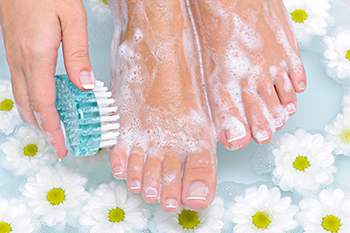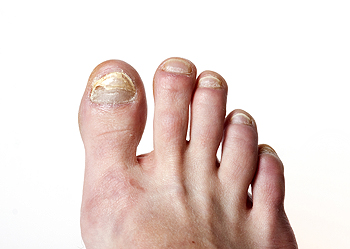Items filtered by date: February 2024
Gout and the Feet

Gout, a form of arthritis, affects the feet due to high uric acid levels. It is well-studied, with genetics playing a significant role. Symptoms can range from none to acute attacks and chronic conditions. Diagnosis involves tests and imaging, such as finding monosodium urate, or MSU, crystals in fluid, and advanced scans help to monitor it. Treatment includes managing flares, chronic issues, and preventing future attacks. Medication, lifestyle changes, and education are key. If you have gout and it is affecting the joints of your feet, it is suggested that you are under the care of a podiatrist for a proper diagnosis and advice in managing this painful condition.
Gout is a foot condition that requires certain treatment and care. If you are seeking treatment, contact Charles Perry, DPM from Ohio. Our doctor will treat your foot and ankle needs.
What Is Gout?
Gout is a type of arthritis caused by a buildup of uric acid in the bloodstream. It often develops in the foot, especially the big toe area, although it can manifest in other parts of the body as well. Gout can make walking and standing very painful and is especially common in diabetics and the obese.
People typically get gout because of a poor diet. Genetic predisposition is also a factor. The children of parents who have had gout frequently have a chance of developing it themselves.
Gout can easily be identified by redness and inflammation of the big toe and the surrounding areas of the foot. Other symptoms include extreme fatigue, joint pain, and running high fevers. Sometimes corticosteroid drugs can be prescribed to treat gout, but the best way to combat this disease is to get more exercise and eat a better diet.
If you have any questions please feel free to contact our offices located in Cambridge and Zanesville, OH . We offer the newest diagnostic and treatment technologies for all your foot and ankle needs.
Do You Suffer From Painful Feet?
Two Types of Hammertoe and Their Treatments
 Hammertoe is a common deformity in which the second, third, or fourth toe is bent at the middle joint. Hammertoes can either be flexible or rigid. Flexible hammertoe is a milder deformity where the affected toe can still be straightened manually, especially when not bearing weight. This type of hammertoe may cause some discomfort, but tends to be more responsive to conservative treatments, such as wearing roomier footwear or using toe cushions. Rigid hammertoe is a more severe form of the condition. This type of hammertoe is stuck in a bent position and cannot be straightened manually. Rigid hammertoe may result in chronic pain, and corns or calluses may develop due to increased pressure and friction against shoes. Podiatrists may use more aggressive treatments, like splinting or surgical intervention, to align the toe properly and alleviate symptoms of rigid hammertoe. If you have a hammertoe, or you are experiencing pain due to this condition, it is suggested that you schedule an appointment with a podiatrist who can provide you with treatment options that are right for you.
Hammertoe is a common deformity in which the second, third, or fourth toe is bent at the middle joint. Hammertoes can either be flexible or rigid. Flexible hammertoe is a milder deformity where the affected toe can still be straightened manually, especially when not bearing weight. This type of hammertoe may cause some discomfort, but tends to be more responsive to conservative treatments, such as wearing roomier footwear or using toe cushions. Rigid hammertoe is a more severe form of the condition. This type of hammertoe is stuck in a bent position and cannot be straightened manually. Rigid hammertoe may result in chronic pain, and corns or calluses may develop due to increased pressure and friction against shoes. Podiatrists may use more aggressive treatments, like splinting or surgical intervention, to align the toe properly and alleviate symptoms of rigid hammertoe. If you have a hammertoe, or you are experiencing pain due to this condition, it is suggested that you schedule an appointment with a podiatrist who can provide you with treatment options that are right for you.
Hammertoe
Hammertoes can be a painful condition to live with. For more information, contact Charles Perry, DPM from Ohio. Our doctor will answer any of your foot- and ankle-related questions.
Hammertoe is a foot deformity that affects the joints of the second, third, fourth, or fifth toes of your feet. It is a painful foot condition in which these toes curl and arch up, which can often lead to pain when wearing footwear.
Symptoms
- Pain in the affected toes
- Development of corns or calluses due to friction
- Inflammation
- Redness
- Contracture of the toes
Causes
Genetics – People who are genetically predisposed to hammertoe are often more susceptible
Arthritis – Because arthritis affects the joints in your toes, further deformities stemming from arthritis can occur
Trauma – Direct trauma to the toes could potentially lead to hammertoe
Ill-fitting shoes – Undue pressure on the front of the toes from ill-fitting shoes can potentially lead to the development of hammertoe
Treatment
Orthotics – Custom made inserts can be used to help relieve pressure placed on the toes and therefore relieve some of the pain associated with it
Medications – Oral medications such as anti-inflammatories or NSAIDs could be used to treat the pain and inflammation hammertoes causes. Injections of corticosteroids are also sometimes used
Surgery – In more severe cases where the hammertoes have become more rigid, foot surgery is a potential option
If you have any questions please contact our offices located in Cambridge and Zanesville, OH . We offer the newest diagnostic and treatment technologies for all your foot and ankle needs.
Tips for Happy, Healthy Feet

Your feet carry you through life's journey, so it's essential to give them the care they deserve. From fungal infections to ingrown toenails, foot problems can be painful and inconvenient. However, with proper care and attention, you can keep your feet happy and healthy. Start by maintaining good hygiene, washing your feet twice daily, and drying them thoroughly, especially between the toes to prevent fungal infections like athlete's foot. Keep your skin moisturized, but avoid applying lotion between the toes to prevent fungal growth. Regularly remove hard skin from your heels and use a heel balm containing urea to prevent cracking. Choose breathable, well-fitting shoes made of leather to reduce perspiration and avoid synthetic materials. Trim your toenails straight across to prevent ingrown toenails, and avoid cutting them too short. Maintain clean environments by regularly bleaching your shower area and wearing sandals in public showers. If you experience persistent foot pain or notice any concerning symptoms in the feet, toes, and ankles, it is suggested that you make an appointment with a podiatrist who is medically trained to deal with these problems.
Everyday foot care is very important to prevent infection and other foot ailments. If you need your feet checked, contact Charles Perry, DPM from Ohio. Our doctor can provide the care you need to keep you pain-free and on your feet.
Everyday Foot Care
Often, people take care of their bodies, face and hair more so than they do for their feet. But the feet are a very important aspect of our bodies, and one that we should pay more attention to. Without our feet, we would not be able to perform most daily tasks.
It is best to check your feet regularly to make sure there are no new bruises or cuts that you may not have noticed before. For dry feet, moisturizer can easily be a remedy and can be applied as often as necessary to the affected areas. Wearing shoes that fit well can also help you maintain good foot health, as well as making it easier to walk and do daily activities without the stress or pain of ill-fitting shoes, high heels, or even flip flops. Wearing clean socks with closed shoes is important to ensure that sweat and bacteria do not accumulate within the shoe. Clean socks help to prevent Athlete’s foot, fungi problems, bad odors, and can absorb sweat.
If you have any questions please feel free to contact our offices located in Cambridge and Zanesville, OH . We offer the newest diagnostic and treatment technologies for all your foot and ankle needs.
Symptoms and Prevalence of Toenail Fungus

Toenail fungus, clinically known as onychomycosis, is a common condition that affects a significant portion of the population. This fungal infection typically occurs when microscopic fungi invade the toenails, leading to discoloration, thickening, and crumbling. The warm and moist environment inside shoes provides an ideal breeding ground for these fungi, making toenails susceptible to infection. Symptoms include changes in nail texture and color, ranging from yellowing to darkening. As the infection progresses, nails may become brittle and emit a foul odor. Toenail fungus is more prevalent than one may think, with a considerable percentage of the population grappling with this condition. Recognizing the symptoms early on is essential for effective management, as untreated toenail fungus can lead to persistent discomfort and potential complications. If you have a toenail fungus infection, it is suggested that you visit a podiatrist who can confirm the diagnosis and offer correct treatment methods, which often includes prescribed medication.
If left untreated, toenail fungus may spread to other toenails, skin, or even fingernails. If you suspect you have toenail fungus it is important to seek treatment right away. For more information about treatment, contact Charles Perry, DPM of Ohio. Our doctor can provide the care you need to keep you pain-free and on your feet.
Symptoms
- Warped or oddly shaped nails
- Yellowish nails
- Loose/separated nail
- Buildup of bits and pieces of nail fragments under the nail
- Brittle, broken, thickened nail
Treatment
If self-care strategies and over-the-counter medications does not help your fungus, your podiatrist may give you a prescription drug instead. Even if you find relief from your toenail fungus symptoms, you may experience a repeat infection in the future.
Prevention
In order to prevent getting toenail fungus in the future, you should always make sure to wash your feet with soap and water. After washing, it is important to dry your feet thoroughly especially in between the toes. When trimming your toenails, be sure to trim straight across instead of in a rounded shape. It is crucial not to cover up discolored nails with nail polish because that will prevent your nail from being able to “breathe”.
In some cases, surgical procedure may be needed to remove the toenail fungus. Consult with your podiatrist about the best treatment options for your case of toenail fungus.
If you have any questions, please feel free to contact our offices located in Cambridge and Zanesville, OH . We offer the newest diagnostic and treatment technologies for all your foot care needs.

